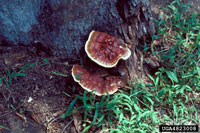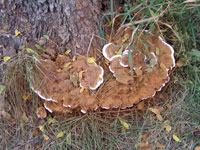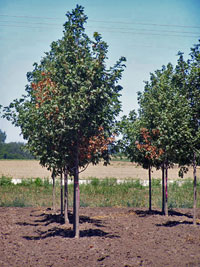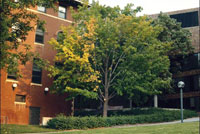Extension > Garden > Diagnose a problem > What's wrong with my plant? > Deciduous Trees > Kentucky coffeetree > Canopy thin, dying branches
Kentucky coffeetree > Trunk/Branches > Canopy thin, dead or dying branches
1 of 2
Ganoderma root and butt rot
Ganoderma spp.
- Leaves are smaller in size and turn yellow earlier than normal
- Canopy appears thin with few leaves and multiple dead branches
- Fungal conks, semicircle shelf fungi, can be found singly or in clusters from the base of the tree up to 3 feet high on the trunk
- Conks are reddish brown and shiny on top, white and porous underneath, a rim of white may be visible on the edge of growing conks
- Infected wood at the base of the tree is white, soft, stringy or spongy
- Infected trees frequently break or fall over in storms
- Most frequent on stressed trees and/or those with mechanical wounds
- More information on Ganoderma butt rot
2 of 2
Verticillium wilt
Verticillium albo-atrum and V. dahliae
- Leaves are small and yellow in chronic infections
- Leaves turn brown from the edges and tips, wilt and die in severe infections
- Leaf symptoms are often seen on only one or a few random branches in the canopy
- Dark streaks often can be seen in the sapwood if the bark is peeled back, appearing as rings or arcs in a cross cut
- Symptoms may develop over a single growing season, or over several years
- More information on Verticillium wilt









